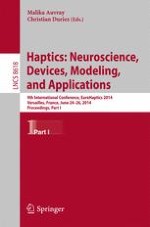2014 | OriginalPaper | Buchkapitel
Adaptation to Motion Presented with a Tactile Array
verfasst von : Sarah McIntyre, Tatjana Seizova-Cajic, Ingvars Birznieks, Alex O. Holcombe, Richard M. Vickery
Erschienen in: Haptics: Neuroscience, Devices, Modeling, and Applications
Verlag: Springer Berlin Heidelberg
Aktivieren Sie unsere intelligente Suche, um passende Fachinhalte oder Patente zu finden.
Wählen Sie Textabschnitte aus um mit Künstlicher Intelligenz passenden Patente zu finden. powered by
Markieren Sie Textabschnitte, um KI-gestützt weitere passende Inhalte zu finden. powered by
